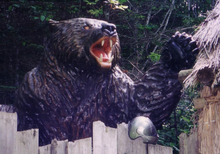This article has multiple issues. Please help improve it or discuss these issues on the talk page. (Learn how and when to remove these messages)
|

The Sankebetsu brown bear incident (三毛別羆事件, Sankebetsu higuma jiken),[1] also known as the Rokusensawa bear attack (六線沢熊害事件, Rokusensawa yūgai jiken) or the Tomamae brown bear incident (苫前羆事件, Tomamae higuma jiken),[2] was a series of bear attacks which took place 9-15 December 1915, at the beginning of the Taishō era, in a remote area of Hokkaido, Japan. Over the course of six snowy days, a male Ezo brown bear attacked a number of households, killing seven people and injuring a further three. The incident has been referred to as "the worst animal attack in Japanese history".[3] The attacks ended when the hungry bear, so smart that it started to trick people, was shot dead.[4][5]
- ^ Laichtman, David Aaron (2020). Onikuma: The Sankebetsu Brown Bear Incident and Japanese Modernity (Thesis).
- ^ Knight, John (2000). "Culling demons: the problem of bears in Japan". In Knight, John (ed.). Natural enemies: people-wildlife conflicts in anthropological perspective. Routledge. pp. 145–169. doi:10.4324/9780203684221. ISBN 978-0-415-22441-3.
- ^ "Fu Watto Tomamae". Archived from the original on 2008-06-20. Retrieved 2008-06-07.
- ^ Dickman, Amy J.; Hazzah, Leela (2016). "Money, Myths and Man-Eaters: Complexities of Human-Wildlife Conflict". Problematic Wildlife. pp. 339–356. doi:10.1007/978-3-319-22246-2_16. ISBN 978-3-319-22245-5.
- ^ Carey Paterson (December 2001). "Higuma, King of the Forest". Xene. Retrieved 2008-06-07.